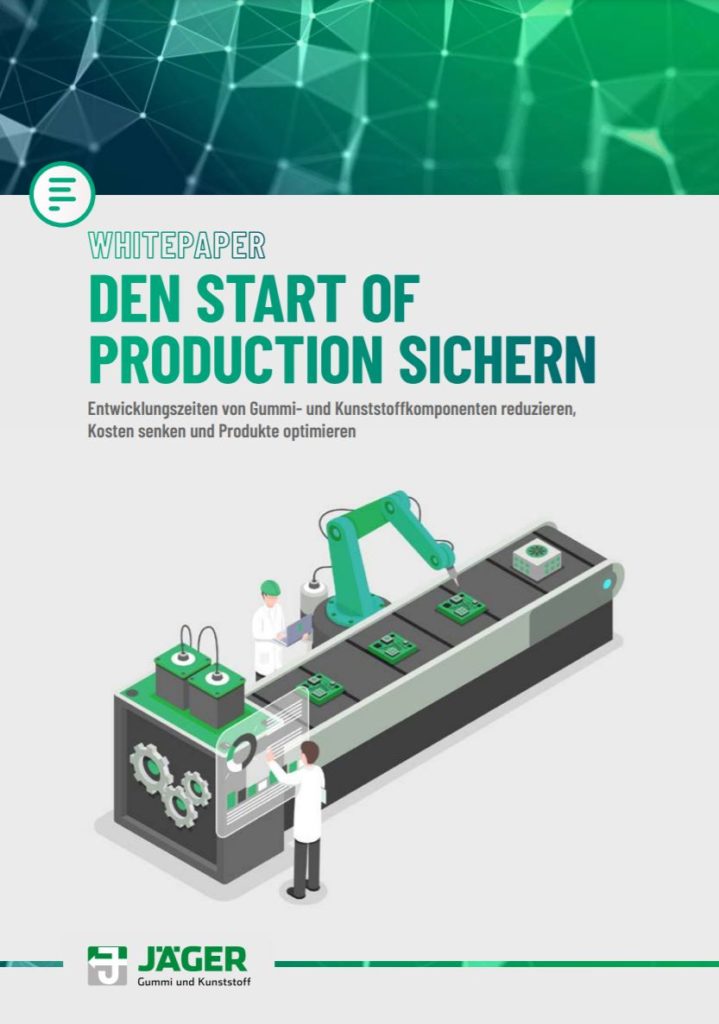
JÄGER Business Blog


WHITEPAPER
Find out which factors influence your SOP!
In development projects for molded plastic and rubber parts, good planning is the be-all and end-all. The more detailed the specifications of the request have been defined in advance, the smoother the project will run. However, it sometimes happens that companies only approach a rubber & plastics producer with a rudimentary catalog of requirements and clarify all the details in a consultation meeting. While this approach is effective, it leads to delays that could have been avoided with some preliminary work and a well-developed specification sheet.
In conventional rubber and plastics projects, specifications are rare. Most customers tend to explain their requirements during a consultation meeting. The reason for this is that many designers come from the metal sector and have little experience with the development of rubber or plastic components. They lack the know-how.
For this reason, many companies prefer to call on the consulting services of a manufacturer and clarify open questions in dialog. As a rule, a specification sheet is still produced in this way, but it is drawn up by the supplier and represents a documentation of what has been discussed.
However, dispensing with an internally prepared requirements specification poses challenges that companies should keep in mind. For example, the rubber and plastics producer’s review of the project request runs much faster and more smoothly if all the important information is already available. Clarifying requirements during the consultation process often means that customers have to discuss open questions internally before production can start. Aspects often come up that the customer has not yet thought about or has not specified to a sufficient degree of detail. This can lead to delays that could have been avoided with a prepared specification.
In addition, a requirements specification can facilitate the selection of a suitable development partner for the project, because the detailed specifications recorded there also represent decision criteria. They allow the supplier to clarify whether he can implement a solution with his existing capabilities and capacities and at what conditions. At the same time, the customer receives valuable feedback, which he can use to better compare the manufacturers contacted.

Discussion between two business partners
The optimal content of a requirements specification (or equivalent checklist) always depends on the project. Information that is essential for one product may be optional for another. Mentioning everything that might be relevant makes it difficult for both sides to identify important key points.
When in doubt, you can use the following list of content commonly found in specifications as a guide:
You should not regard this overview as the binding structure of a specification, but rather as a checklist. Go through each item and decide which aspects are relevant to your project. If you are unsure, include the topic in your specifications and address it in the consultation meeting.
Preparing a specification sheet before making an inquiry to a rubber and plastics producer is an effort that many companies shy away from. They prefer to clarify their requirements in direct dialog with the supplier. However, this procedure has its pitfalls. Questions often arise that the customer cannot answer ad hoc, or aspects that must first be clarified internally. In addition, companies give up a tool that can help them pre-select potential development partners. Both can delay the start of the project. It is therefore advisable to clarify the requirements for the rubber or plastic article as far as possible before contacting them and to document them in a specification sheet.

Whitepaper: Secure the Start of Production
Learn which factors influence your SOP!

Jörg Zitzelsberger has been part of the Jäger Gummi und Kunststoff team since 1993. With many years of experience, he serves our customers as head of the Stuttgart location.
Share post now!
Jäger Gummi und Kunststoff GmbH
Lohweg 1
30559 Hannover
Tel. +49 511 – 53580
Fax +49 511 – 553394
info@jaeger-gk.de
Management:
Dipl.-Ing Sebastian Jäger
Julius Jäger, M.Sc.
Hanover Register Court HRB 59798
DE 813 314 161

Petra Dirlenbach